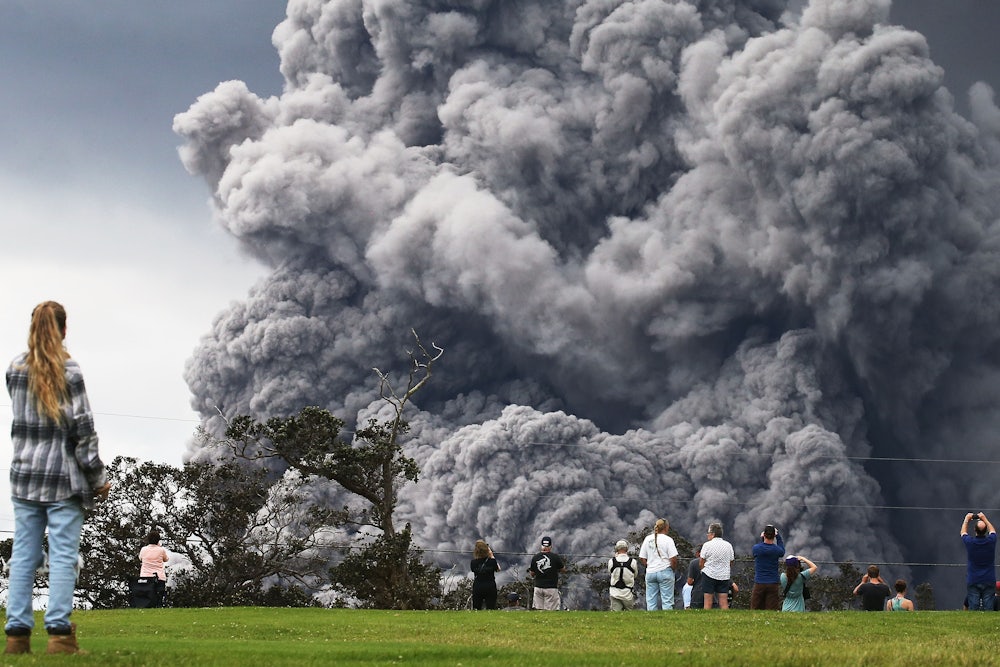Maarten de Moor would like to clear up a few things about the dramatic, weeks-long eruption of Hawaii’s Kilauea volcano.
Kilauea’s spectacular explosions won’t set off earthquakes on America’s West Coast. They won’t cause a tsunami, either. They won’t trigger a bigger, more catastrophic eruption like the one of Mount Pinatubo, in the Philippines, in 1991. “Not gonna happen,” de Moor, a volcanologist, said. And even though Kilauea is emitting lots of carbon dioxide, it won’t worsen global warming to any meaningful degree. “That one,” he said, “is just not based on any facts at all.”
Each of these myths about Kilauea have spread on the internet in one form or another since the volcano began spewing lava on May 3. They’ve been largely debunked thanks to scientists like de Moor, who monitors volcanic emissions for the Deep Carbon Observatory and the Volcanological and Seismological Observatory of Costa Rica. The Associated Press, for example, corrected its May 13 story that wrongly stated that Kilauea was part of the “Ring of Fire,” a belt of severe seismic activity that surrounds the Pacific Ocean. The popular-science publications Earther and National Geographic have also published extensive articles refuting most of these claims.
But one of these myths has been especially persistent.
“I would say they are all equally egregious, because in all cases we have scientific data and observations that refutes them,” said volcanologist Simon Carn, as associate professor at Michigan Tech. “However, the climate change myth is most persistent as it comes up after every significant eruption.”
Carn has been a central figure on volcano Twitter since Kilauea began its explosive activity earlier this month. As such, he was among the first to draw attention to an NBC News video, “What the Mount Kilauea eruptions mean for climate change,” featuring just one scientist: Peter Ward, a volcanologist who has long argued that global warming is caused by ozone depletion. (The scientific consensus is that greenhouse gases cause global warming.)
In the NBC piece, Ward said that basaltic volcanoes—black-rock volcanoes with low silica content—like Kilauea “can contribute to significant changes in the climate” through large emissions of chlorine and bromine. Ward described these elements as chlorofluorocarbons, which deplete ozone. Ward and the narrator then asserted that ozone depletion causes global warming.
According to Carn, though, basaltic volcanoes don’t actually emit that much chlorine or bromine. And whatever they do emit is a naturally occurring form of those elements—and thus would not be chlorofluorocarbons, which are man-made combinations of those elements. Ozone is also a greenhouse gas, Carn noted, so depleting it would cause global cooling, not warming.
Carn said on Twitter that NBC should be “ashamed” of publishing the piece without consulting other scientists. “It is B.S. of the highest order,” he wrote.
If you see this, please ignore it. It is BS of the highest order and @NBC/@NBCNewsMACH should be ashamed for not fact-checking with other scientists. Peter Ward is the proponent of some totally unsubstantiated theories linking SO2 emissions to global warming. https://t.co/3T7RsoOPPs
— Simon Carn (@simoncarn) May 21, 2018
But a piece like NBC’s was almost inevitable, given the long history of climate-change deniers blaming volcanoes for the phenomenon. Usually, those arguments are based on the fact that volcanoes emit lots of carbon dioxide when they erupt. In that sense, Ward’s argument that volcanoes produce ozone—and that ozone causes climate change—was at least somewhat original.
But both arguments lack supporting evidence. Year-over-year, humans produce 100 times more carbon dioxide than volcanoes—even when there’s a big eruption. “Volcanic output of greenhouse gases is roughly matched by ocean and terrestrial carbon uptake,” said climatologist Michael Mann, the director of the Earth System Science Center at Penn State. “So unless there is a dramatic upsurge in volcanic activity, it doesn’t contribute at all—the background rate of volcanic outgassing is already nearly balanced out by natural carbon uptake. The imbalance is so small that it has to add up over millions of years to amount to anything significant.”
Compared to past eruptions, de Moor thinks Kilauea isn’t even that big in terms of carbon dioxide output. Though he doesn’t have exact measurements, he estimates that Kilauea is emitting around 15,000 metric tons of carbon dioxide per day. (He calculated this based on measurements of sulfur dioxide from Kilauea and the typical ratio of sulfur dioxide to carbon dioxide emissions from eruptions.) Fifteen thousand metric tons of C02 is roughly equivalent to how much is emitted by a large coal-fired power plant in a day and a half, according to the Environmental Protection Agency.
There is one other powerful greenhouse gas being caused by Kilauea, as its lava burns through organic matter: methane. But that’s “a really local effect,” de Moor said. “It’s not going to have any big impact on anything global.”
In reality, massive eruptions are more likely to cool the Earth than warm it. According to the U.S. Geological Survey, “The most significant climate impacts from volcanic injections into the stratosphere come from the conversion of sulfur dioxide to sulfuric acid,” which causes more “reflection of radiation from the Sun back into space, cooling the Earth’s lower atmosphere or troposphere.” The Pinatubo eruption in 1991, for instance, “was a standout in its climate impact and cooled the Earth’s surface for three years following the eruption, by as much as 1.3 degrees F at the height of the impact.”
Kilauea’s latest outburst isn’t big enough for such an impact. And for the sake of Hawaii’s Big Islanders, let’s hope it remains that way.
